By Subject: Child Welfare | Early Care and Education | Home Visiting | K-12 Education | Perinatal and Child Health | Prenatal-to-Age-Three | KIDSCOUNT State of the Child
Child Welfare Reports and Fact Sheets
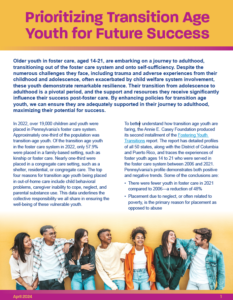
Fact Sheet: Prioritizing Transition Age Youth for Future Success – April 2024
Older youth in foster care, aged 14-21, are embarking on a journey to adulthood, transitioning out of the foster care system and onto self-sufficiency. Despite the numerous challenges they face, including trauma and adverse experiences from their childhood and adolescence, often exacerbated by child welfare system involvement, these youth demonstrate remarkable resilience. Their transition from adolescence to adulthood is a pivotal period, and the support and resources they receive significantly influence their success post-foster care.

Report: 2023 State of Child Welfare – December 2023
Our 14th annual State of Child Welfare report provides a 5-year analysis of how Pennsylvania fares with practices around child safety, placement, and permanency and includes county-level data and statewide and geographic trends to improve the child welfare system. We continue to analyze racial disparity and disproportionality across the child welfare system’s population (age 0-20).

Fact Sheet: Improving Kinship Placement in Pennsylvania – September 2023
Kinship care is the full-time care, nurturing, and protection of a child by a relative, either by blood or marriage, and can include informal connections that are not legally related but have a positive, supportive relationship with the child or family.
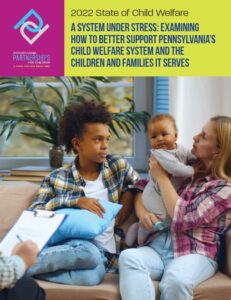
Report: 2022 State of Child Welfare – September 2022
Our 13th annual State of Child Welfare report provides a 5-year analysis of how Pennsylvania fares with practices around child safety, placement, and permanency and includes county-level data and statewide and geographic trends to improve the child welfare system. We continue to analyze racial disparity and disproportionality across the child welfare system’s population (age 0-20).
Early Care and Education Reports and Fact Sheets

Fact Sheet: Supporting Infant and Toddler Early Intervention in Pennsylvania – April 2024
Infant and Toddler EI is a program that provides services to children from birth to 3 years who have a developmental delay or a high probability of having a developmental delay. Also referred to as Part C EI, these services aim to improve outcomes that are critical to a family’s ability to support their child’s health, optimal development, educational success, and lifelong well-being.
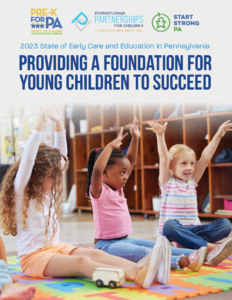
Report: State of Early Care and Education in Pennsylvania – August 2023
Pennsylvania’s comprehensive early care and education system spans a child’s formative years, from birth-to-age-5. This report looks deeper at Pennsylvania’s child care and pre-k system complexities and recommends the improvements necessary to ensure the system functions equitably and increases access and affordability for all families in the commonwealth.

Report: Pennsylvania Must Strengthen Its Professional Development Registry to Support Early Childhood Educators – Start Strong PA – January 2023
Start Strong PA is a statewide campaign of partners advocating for increased access to high-quality, affordable child care, beginning with infants and toddlers. The campaign is concerned with the current workforce crisis facing child care providers and families looking for high-quality care.
Home Visiting
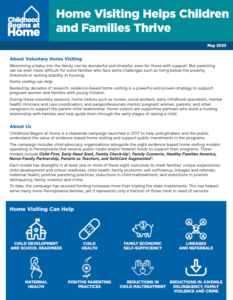
Home Visiting State and County Fact Sheets 2023
The Childhood Begins at Home campaign released new fact sheets that show the number of young children and their families receiving publicly funded, evidence-based home visiting services statewide and in each county. While a historic level of increased funding in last year’s state budget helped serve more Pennsylvania low-income families—moving from 5% to 7% served—it still represents only a fraction of those most in need of services.
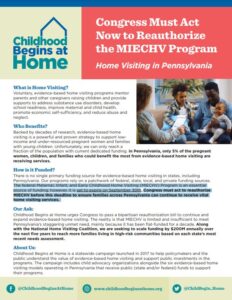
Fact Sheet: Congress Must Act Now to Reauthorize the MIECHV Program – July 2022
The Maternal, Infant, and Early Childhood Home Visiting (MIECHV) program strengthens communities by improving outcomes for children and their families. A cornerstone of evidence-based public policy, MIECHV provides funds for developing and implementing voluntary, evidence-based home visiting programs. Programs must meet at least four of six evidence-based benchmarks to satisfy the law’s rigorous requirements for demonstrated effectiveness. MIECHV is an essential source of funding; however, it is set to expire on September 30th. Congress must act to reauthorize MIECHV before this deadline to ensure families across Pennsylvania can continue to receive vital home visiting services.
K-12 Education Reports and Fact Sheets
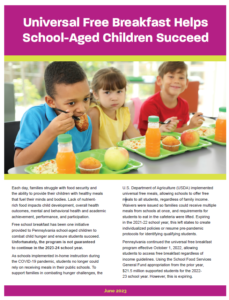
Fact Sheet: Universal Free Breakfast Helps School-Aged Children Succeed – June 2023
Each day, families struggle with food security and the ability to provide their children with healthy meals that fuel their minds and bodies. Lack of nutrient-rich food impacts child development, overall health outcomes, mental and behavioral health and academic achievement, performance, and participation. Free school breakfast has been one initiative provided to Pennsylvania school-aged children to combat child hunger and ensure students succeed.
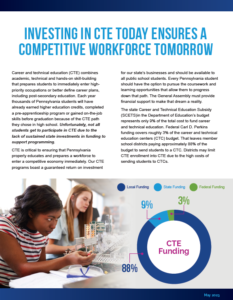
Fact Sheet: Investing in CTE Today Ensures a Competitive Workforce Tomorrow – May 2023
Career and technical education (CTE) combines academic, technical and hands-on skill-building that prepares students to immediately enter high-priority occupations or better define career plans, including post-secondary education. Each year thousands of Pennsylvania students will have already earned higher education credits, completed a pre-apprenticeship program or gained on-the-job skills before graduation because of the CTE path they chose in high school. Unfortunately, not all students get to participate in CTE due to the lack of sustained state investments in funding to support programming.

Fact Sheet: What Do Funding Streams Look Like for Career and Technical Education Centers? – February 2023
Career and technical education (CTE) provides a unique combination of academic, technical, and hands-on skill-building that prepares students to either immediately enter the workforce or better define career plans to enter post-secondary education. Funding for CTE is complex, with several streams from federal, state and local funding. Funding sources vary.
Perinatal and Child Health Reports and Fact Sheets
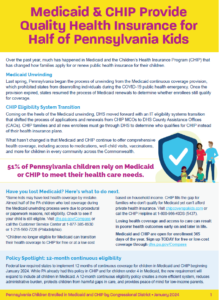
Fact Sheets: Medicaid & CHIP Provide Quality Health Insurance for Half of Pennsylvania Kids – February 2024
Over the past year, much has happened in Medicaid and the Children’s Health Insurance Program (CHIP) that has changed how families apply for or renew public health insurance for their children. The three fact sheets in this series show enrollment by Congressional, state House, and state Senate districts.

Report: State of Children’s Health in Pennsylvania – November 2023
The 2022 State of Children’s Health Report shows the factors that contribute to a child’s likelihood of being uninsured include family income, race and ethnicity, geography, and age. It uses the most recent Census data and examines the role of public health insurance programs as comprehensive coverage options and how Medicaid continues to provide a safety net of coverage during the COVID-19 public health emergency.
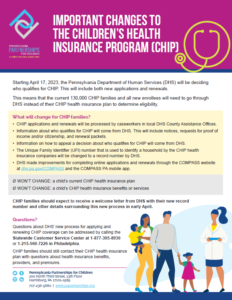
Fact Sheet: Important Changes to the Children’s Health Insurance Program (CHIP) – April 2023
Beginning April 17th, the Pennsylvania Department of Human Services will determine eligibility for CHIP families and new enrollees, not CHIP insurance plans. This change means County Assistance Offices will process all renewals and new applications.
Prenatal-to-Age-Three Reports and Fact Sheets
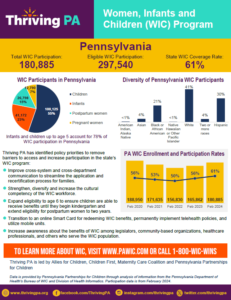
Fact Sheets: Prenatal and Children’s Nutrition (Women, Infants and Children Program – WIC) – April 2024
Children need access to nutrition for their growing bodies and minds to be healthy and develop as they should. The Special Supplemental Nutrition Program for Women, Infants, and Children (WIC) is a critical component in ensuring infants and toddlers, as well as pregnant and postpartum mothers, have access to healthy nutrition. See WIC coverage rates statewide and at the county level.
KIDSCOUNT State of the Child
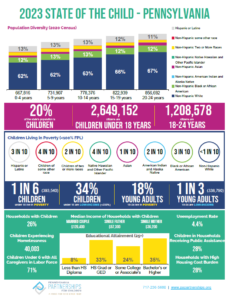
State of the Child 2023
Our revamped State of the Child profiles offer a variety of data points about children and families and their well-being in Pennsylvania and all 67 counties, including Population Diversity, Children Living in Poverty, and a variety of Socioeconomic Data. Click on page to see county statistics.
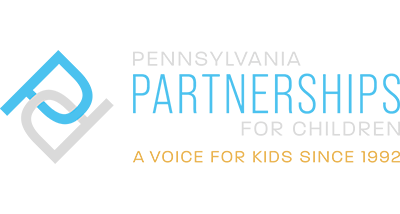
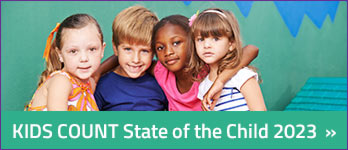
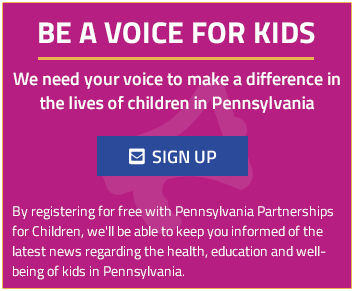

PAP4Children Follow 9,904 2,626
Pennsylvania Partnerships for Children is dedicated to improving the well-being of PA's 2.6 million kids. We're independent, non-partisan and non-profit.
It's Thursday, and you know what that means. It's time for your next PPC #summerreadinglist assignment! If you want to learn more about Medicaid & CHIP, this is the fact sheet for you. If you're interested in data, this is ALSO something for you. https://ow.ly/sfnI50SFcR5
Happy National #BeAGoodTeammateDay! Want to meet some of our favorite teammates? Meet the PPC team! https://ow.ly/wo4Q50SG4v1
Happy #NationalIceCreamDay! Stay cool with some ice cream and by signing up for our email list. Nothing is cooler than data...right? https://ow.ly/jfv950SEwnL
Check out this new report from the Annie E. Casey Foundation - New Insights on State Kinship Diversion Policies
New Insights on State Kinship Diversion Policies
Kinship diversion can help keep kids out of foster care. Review state policies and understand why engaging family in these arrangements matters.
www.aecf.org